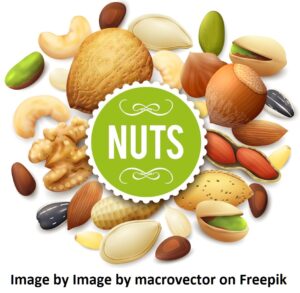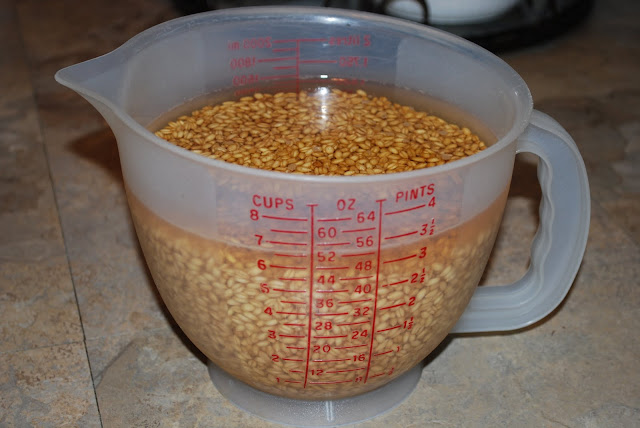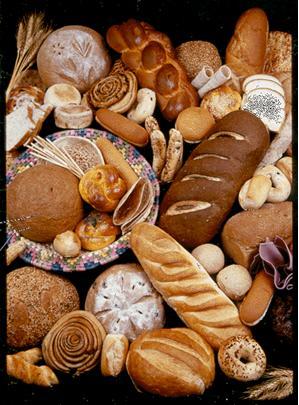Harmful food lectins (prolamin and agglutinin in grains, legumes, nuts, seeds) need to be properly prepared
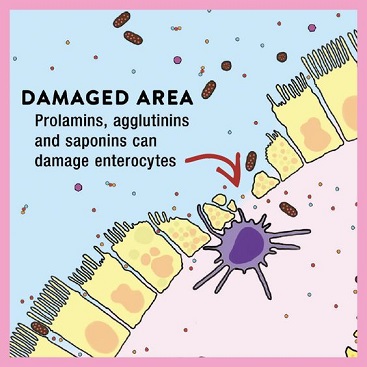
What are lectins?
All seeds contain lectins in their seed coats and cotlyledons (part that becomes the first leaves in some plants). Highest concentrations are found in grains and legumes (includes peanuts, soybeans and beans), and also found in abundance in nuts, seeds (other than grains), members of the nightshade family of plants (including tomatoes, peppers, eggplants and potatoes), and seafood. About 30% of fresh foods contain lectins in varying amounts.
Which foods have the highest concentrations of harmful lectins?
Lectins are carbohydrate-binding proteins that attach to cell membranes. E.g. Glycoproteins (protein + sugar molecules) are found on the outside of the cell membrane, with the sugar (oligosaccharides – the strings of blue circles in the diagram) facing out, making it accessible for lectins to latch onto.
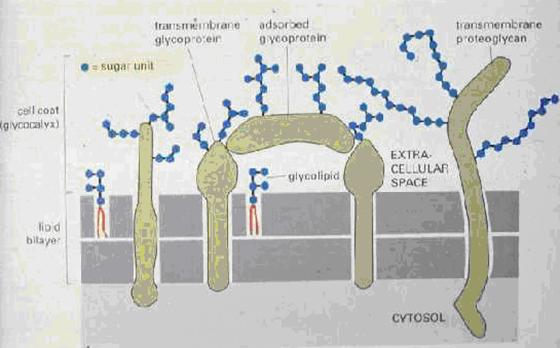
Oligosaccharide side chains attached to membrane glycolipids and glycoproteins
Lectins have essential functions in all life forms
- In our bodies. Lectins allow cell-to-cell adherence, inflammation control and programmed cell death; many types of cell receptors are lectins;
- Part of plants’ natural defense mechanisms. Important for seed survival, lectins discourage pests from eating them e.g. insects, bacteria, fungi, man??? 🙂 Their intent is generally to repel (not kill) predators by stimulating a negative reaction, although some lectins have proven fatal to various microorganisms.

Which foods have the highest concentrations of harmful lectins?
Most food sources contain lectins in varying concentrations. However, we only know of two types of lectins that we need to be concerned about from a health perspective (i.e. prolamins and agglutinins), and to attain a low-lectin diet, the foods containing high amounts of these need to be either avoided or appropriately prepared to reduce their harmful lectin content.
Foods with the highest lectin amounts:
- Grains. Wheat (wheat bran and wheat germ); includes: bulgur, durum, farina, graham, kamut, matzah, seitan, semolina, spelt), barley, rye, triticale (hybrid of wheat and rye); not so much in oats (unless they have been cross-contaminated with high-lectin grains, e.g. by being grown beside wheat, rotated with wheat crops or during processing). Grains are the seeds of grasses;
- Legumes. Soybean (contain soybean agglutinin (SBA)), peanuts (contain peanut agglutinin), beans (oval-shaped) and lentils (disc-shaped) are the seeds of plants of the Leguminosae family, which enclose their seeds inside pods. High lectin amounts are found in soy, peanuts, kidney beans, mung beans, lentils, fava beans, chickpeas, carob, green and yellow peas.
- Certain nuts and their oils. Especially cashew nuts; nuts are the seeds of trees;
- Other edible seeds. Especially sunflower, pumpkin, chia seeds;
- Dairy / dairy products from grain-fed A1 casein milk-producing cows (most grocery store cow milk). ~80% of milk protein is casein of which beta casein is the major type – having two forms A1 and A2; A1 casein is a lectin-like protein that converts to beta-casomorphin-7 (BCM-7), an opioid peptide that can trigger an immune system attack in the body.
In the U.S., 90% of milk is from A1 casein-producing Holstein-Friesian cows. A1 casein is also produced by Ayrshire and British shorthorn breeds; Goats and most Jersey and Guernsey cows produce A2 casein content milk. Pasteurization reduces SIgA, an immunoglobulin that naturally binds lectins.
- Skins/seeds of nightshade family plants. White potatoes, eggplants, peppers, tomatoes
- Squash, pumpkins, zucchini
- GMO plant foods. GMOs often have lectins spliced into them to protect the plant from pests.
Most potent plant lectins are in a plant’s seeds, roots, young shoots, and bark
In plant seeds, lectins are mainly in the cotyledon within the seed embryo. The cotyledon becomes first leaves of epigeal plants, which germinate above ground, E.g. soybean, peanuts, common beans, French bean, mustard, cress, sunflower, pumpkin, watermelon, cucumber, gourds). In hypogeal plants, which germinate underground, the cotyledon remains in the soil E.g. wheat, corn/maize, barley, broad bean, scarlet runner bean, green peas.
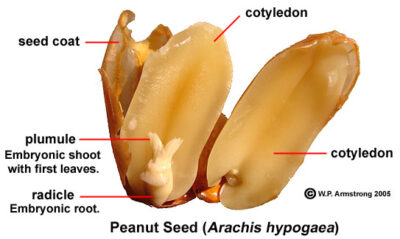


Prolamins and agglutinins: The dietary lectins that cause health problems
Prolamins and agglutinins are currently the only two classes of lectins widely recognized as antinutrients in food
However, it is important to note that the presence of these harmful lectins can be significantly reduced with appropriate food preparation. Lectins have the ability to bind to virtually all cell types, but when they bind to glycoproteins on the epithelial surface of the small intestine, they can elicit both local and/or systemic reactions involving:
- Damage /inflammation
- Breach of the gut lining
- Immune system modulation
- Dysbiosis (an imbalance in gut flora)
- Nutrient malabsorption.
Prolamins and agglutinins can cause some serious health problems in those genetically susceptible to their effects. E.g. WHOLE wheat contains the prolamin gliadin and several agglutinins, including wheat germ agglutinin (WGA) (0.5g / kg). Gliadin is one of the more infamous lectins – being the digestive-troubling half of the gluten molecule that affects those with gluten-sensitivity. WGA and other food agglutinins, affect us all to some degree, but in those more prone to its effects, it can wreak havoc in their gut and body tissues, leaving a wake of inflammatory devastation that results in any of a long list of common health problems, including rheumatoid arthritis, chronic candida, allergies, diabetes . . . and many others.
Health Effects of Lectins (Being Updated)
We are eating far more whole grains than we used to eat. Before the agricultural revolution with the introduction of big-farming methods, grains were a small part of our diet, now they are readily available to us in quantity with a quick trip to the grocery store — think bread, crackers, pasta, rice and cereals. Yes of course, whole grains are certainly more nutritious than refined grains, but eating too many whole grains also introduces an abundance of harmful antinutrients, such as lectins and phytic acid.
Traditional food preparation methods can remove some lectins. To wit: soaking, sprouting, fermenting and cooking. However, agglutinins tend to resist degradation.
Prolamins (have a high content of proline and glutamine amino acids)
Prolamins can cause inflammation / damage to intestinal wall, immune system modulation, alter gut microbiome (dysbiosis);
Prolamins are prevalent in grains. They include:
- Gliadin (a component of gluten) – mainly in wheat, rye, barley and triticale; there are 3 gliadin groups: α/β-gliadins, γ-gliadins, and ω-gliadins. The digestive-troubling half of gluten (the other 50% is glutenin), responsible for digestive problems in those with celiac disease.
- Wheat seed. 2.8% – 8.8% gliadin (~40% of its 7-22% protein). Although refined wheat products contain less wheatgerm agglutinin (WGA) than unrefined wheat, they still contain a substantial amount of gluten:
- All-Purpose Flour. 3.2% – 4.4% gliadin (~40% of its 8% -11% protein); hard/soft berry blend; bleached flour has less protein/gluten/gliadin than unbleached flour.
- Bread flour. 4.8% – 5.6% gliadin (~40% of its 12% – 14% protein ); hard high-protein wheat; unbleached;
- Zein. In corn
- Secalin. In rye
- Avenin. In oats, but generally in very small amounts in rolled oats (unless cross-contaminated with other grains)
The grains with the highest amount of inflammation-provoking amino acid sequences in prolamins. Include Wheat, Barley, Oats, Rye, Semolina, Bulgar, Durum, Kamut, Spelt, Triticale.
Some grains, even though they contain gluten, do not have significant amounts of prolamins (such as gliadin). These are usually tolerated by those with Celiac Disease. These include Rice, Corn, Buckwheat , Millet,Sorghum, Teff, Quinoa, Amaranth and possibly Einkorn wheat.
Agglutinins
Agglutinins have ability to clump red blood cells together (i.e. agglutinate);
Agglutinins can cause inflammation and damage to intestinal wall;
Which foods contain high levels of agglutinins?
- GMO wheat, corn and soybeans are “designed” to have higher amounts of agglutinins in their seed coats (increases crop yield by countering fungal infections);
- Agglutinins are prevalent in wheat germ, peanuts, cashews, kidney beans and soy beans;
- Concentration of agglutinins in different types of legumes varies dramatically. They can be reduced in most beans by soaking PLUS high-heat boiling; However, wheat germ agglutinin (WGA) and agglutinins in soybeans, peanuts and kidney beans resist the degradation of their agglutinins by traditional food preparation methods.
- Refined wheat germ contains less WGA than unrefined. However, several wheat products still contain some active WGA:
| Amount of active Wheat Germ Agglutinin (WGA) in commonly consumed wheat products | ||
|---|---|---|
| Wheat-Derived Products | WGA μg/g (±SD) | Reference Source |
| Wheat germ | 300 (±35) | Vincenzi et al.; 2000 Ref |
| Wheat germ | 100-500 | Peumans and Van Damme, 1996[Ref] |
| Flour * | 4.3 (±0.7)-4.4 (±1.0) | |
| Whole meal flour * | 29.5 (±2.5)-50 (±5.5) | |
| Pasta * (uncooked) | ≤ 0.4 (±0.2)-3.2 (±0.2) | |
| Pasta (cooked) * | ≤ 0.3 (±0.2) | |
| Whole meal pasta (enriched with wheat germ} (uncooked) | 40 (±2.7) | |
| Whole meal pasta (enriched with wheat germ) (cooked) | Not detectable | |
| Whole meal pasta * (uncooked) | 0-5.7(±0.2) | |
| Whole meal pasta * (cooked) | Not detectable | |
| Breakfast cereals * (assessed by hemagglutination and bacterial agglutination assays) | 13-53 | Nachbar et al,1980 PubMed Ortega-Barria et al., 1994 PubMed |
* values obtained from multiple products and different manufacturers
Karin de Punder et al, The Dietary Intake of Wheat and other Cereal Grains and Their Role in Inflammation, Nutrients Mar 2013 5930; 771-787 PubMed

How to reduce lectins in the diet
Lectins are “unshaken” by stomach acid and generally resist digestion by intestinal enzymes
Many food lectins can be deactivated with appropriate food preparation
Traditional cultures used preparation methods to reduce food lectins. Understanding the need for soaking, fermenting, or high-heat boiling etc., to reduce lectins in seeds having a high lectin concentration. However, modern day Western cultures generally don’t make the effort to ensure that even their primary sources of food are low in lectins.
Sprouting and overnight-soaking do not have much effect on gluten levels (gluten is hard for us to digest and absorb). Only sourdough bread made traditionally using 3-day fermentation (souring) will be gluten-free. Be aware that many sourdough breads sold are not gluten-free because they are not traditional sourdough breads – the real thing will list a sourdough starter instead of yeast in their ingredient list.
Soaking and boiling
The amount of most lectins in foods can be significantly reduced by PRE- SOAKING foods and then bringing them to a ROLLING BOIL in fresh water for 15 minutes. Cooking breaks down some plant starch into simpler carbohydrates; lectins attach to these carbohydrates, which essentially deactivates the lectins by “tying them up”. Eating raw or undercooked kidney beans will cause severe vomiting because of their lectin toxicity.
- Slow cookers do not reach a high enough temperature to effectively deactivate lectins
- Pressure cookers do a superlative job. Especially with beans, tomatoes, potatoes and quinoa; but will not reduce lectins in wheat, rye, barley or spelt.
Dry heat
Dry heat (baking or roasting) is not as effective as prolonged boiling. E.g. baked goods made with grain or bean flours contain more lectins than boiled products.
- Dry roasting deactivates about 75% of the lectins in raw peanuts.
- Toasted wheat germ still contains a significant amount of active lectins.
Sprouting
Sprouting is not as effective as prolonged boiling. Although some of the nitrogen-containing lectin is broken down to nourish the young seedling, some lectins remain to protect it from predators as it grows. With some seeds, such as alfalfa sprouts, sprouting actually enhances lectin content.
Fermentation / Souring
Soy. if you eat soy, choose organic, fermented soy products E.g. natto, miso, tempeh;
Sourdough bread. Traditionally made sourdough bread has low-lectin content;
Beer. Is fermented grains;
Other lectin-reducing tactics
Peel and deseed high-lectin plant foods. Remove skins and any seeds from potatoes, tomatoes, sweet peppers, eggplants, zuccini, pumpkins, squash
Choose refined foods
- Eat white grains instead of improperly prepared whole grains. E.g. If you must eat bread, eat white refined wheat bread (sourdough is best) instead of whole wheat.
- Eat white rice instead of brown rice
Fermentation. Fermenting vegetables allows good bacteria to break down a significant number of lectins. They also become good sources of probiotics















